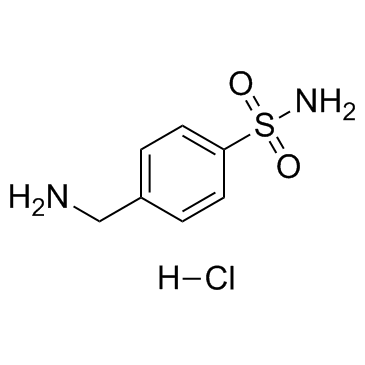138-37-4
| Name | Mafenide hydrochloride |
|---|---|
| Synonyms |
α-Amino-p-toluenesulfonamide hydrochloride
4-(Aminomethyl)benzenesulfonamide hydrochloride p-Toluenesulfonamide, α-amino-, hydrochloride 4-(Aminomethyl)benzenesulfonamide hydrochloride (1:1) HoMosulfaMine Hydrochloride 4-(aminomethyl)benzenesulfonamide,hydrochloride MFCD00013005 Mafenide HCl p-Toluenesulfonamide, α-amino-, monohydrochloride 4-Aminomethylbenzenesulfonamide hydrochloride a-amino-p-toluenesulfonamide hydrochloride 4-Homosulfanilamide,Mafenide,Marfanil EINECS 205-325-3 Benzenesulfonamide, 4-(aminomethyl)-, hydrochloride (1:1) Mafenide Hydrochloride Benzenesulfonamide, 4- (aminomethyl)-, monohydrochloride Mafenide (hydrochloride) |
| Description | Mafenide hydrochloride is a sulfonamide-type medication used as an antibiotic.Target: AntibacterialMafenide is a sulfonamide-type medication. Mafenide works by reducing the bacterial population present in the avascular tissues of burns and permits spontaneous healing of deep partial-thickness burns. It is used to treat severe burns. It is used topically as an adjunctive therapy for second- and third-degree burns. It is bacteriostatic against many gram-positive and gram-negative organisms, including Pseudomonas aeruginosa. Some sources state that mafenide is more appropriate for non-facial burns, while chloramphenicol/prednisolone or bacitracin are more appropriate for facial burns [1-3]. |
|---|---|
| Related Catalog | |
| References |
[2]. Haynes, B.W., Jr., Mafenide acetate in burn treatment. N Engl J Med, 1971. 284(23): p. 1324. [3]. Haik, J., et al., Burn care standards in Israel: lack of consensus. Burns, 2005. 31(7): p. 845-9. |
| Boiling Point | 382ºC at 760mmHg |
|---|---|
| Melting Point | 261-263 °C(lit.) |
| Molecular Formula | C7H11ClN2O2S |
| Molecular Weight | 222.692 |
| Flash Point | 184.8ºC |
| Exact Mass | 222.022980 |
| PSA | 94.56000 |
| LogP | 3.07610 |
CHEMICAL IDENTIFICATION
HEALTH HAZARD DATAACUTE TOXICITY DATA
|
| Symbol |

GHS07 |
|---|---|
| Signal Word | Warning |
| Hazard Statements | H317 |
| Precautionary Statements | P280 |
| Personal Protective Equipment | dust mask type N95 (US);Eyeshields;Faceshields;Gloves |
| Hazard Codes | Xn: Harmful; |
| Risk Phrases | R42/43 |
| Safety Phrases | S22-S36/37-S45 |
| RIDADR | NONH for all modes of transport |
| WGK Germany | 2 |
| RTECS | XT5425000 |
| HS Code | 2935009090 |
| Precursor 0 | |
|---|---|
| DownStream 3 | |
| HS Code | 2935009090 |
|---|---|
| Summary | 2935009090 other sulphonamides VAT:17.0% Tax rebate rate:9.0% Supervision conditions:none MFN tariff:6.5% General tariff:35.0% |


![6-oxo-6-[(4-sulfamoylphenyl)methylamino]hexanoic acid structure](https://image.chemsrc.com/caspic/244/142319-48-0.png)

![4-nitro-N-[(4-sulfamoylphenyl)methyl]benzamide structure](https://image.chemsrc.com/caspic/412/50889-01-5.png)